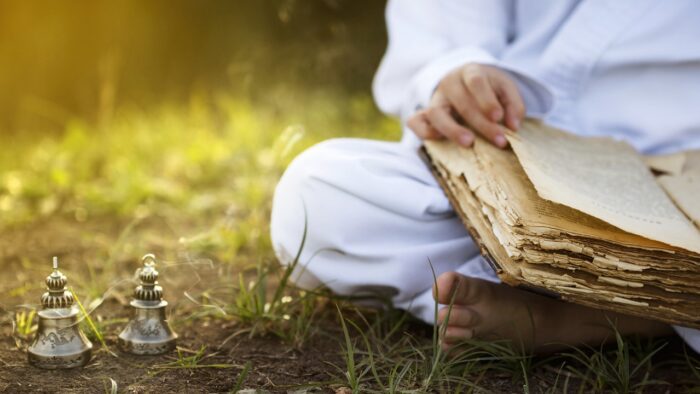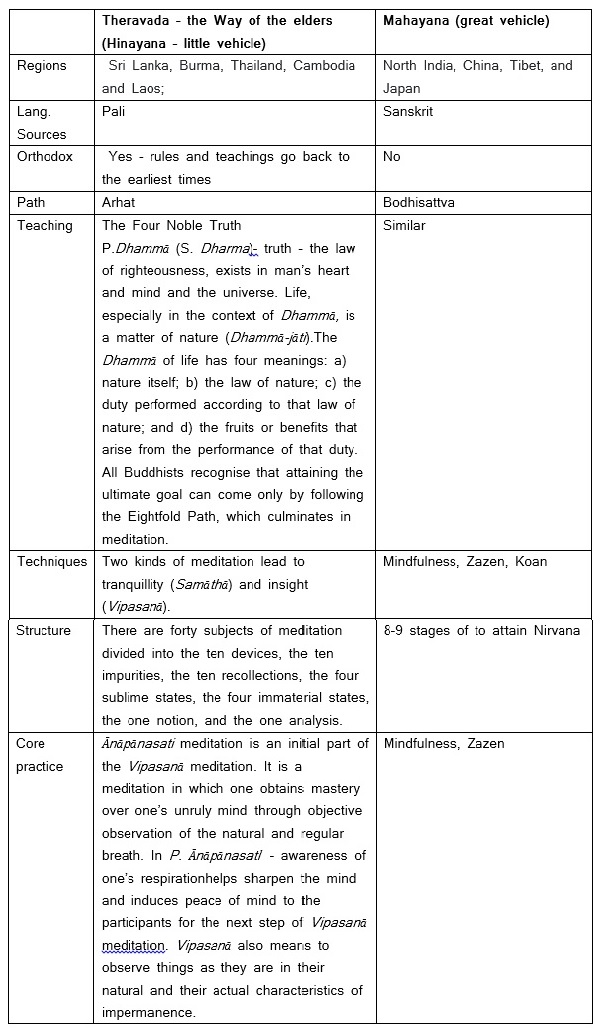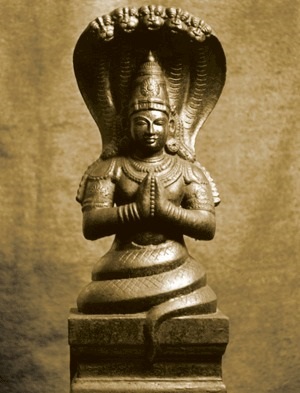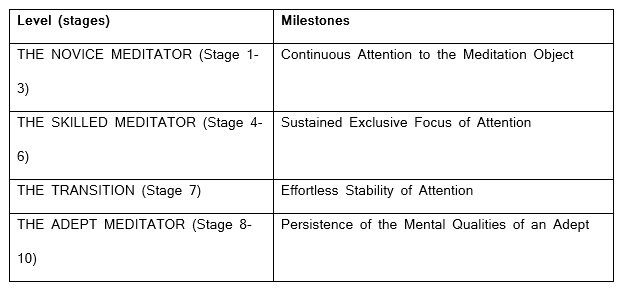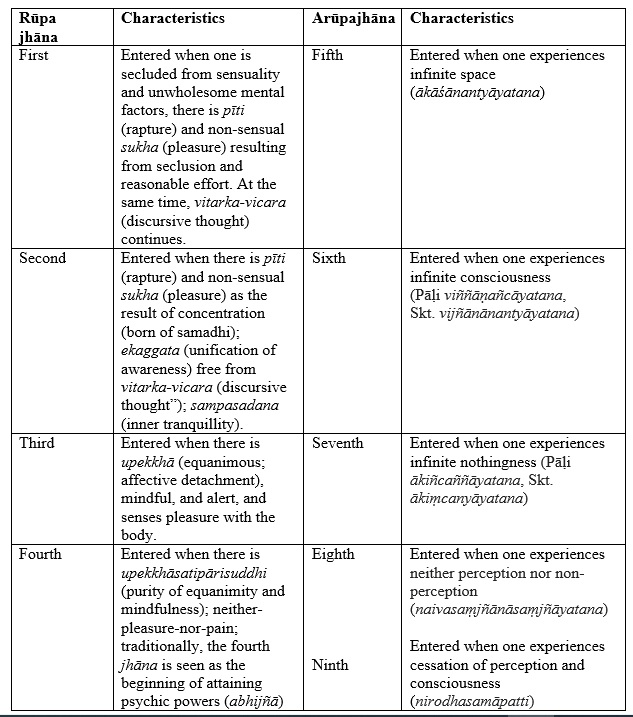Without a doubt, Patānjali’s Yogasutra is a systematic review of knowledge on dhyāna till 200 BCE. Knowledge on this topic has grown exponentially since the seminal work in the Yogasutra. To what extent can Buddhist schools enhance our understanding of the path laid by Patānjali’saśtānga yoga? And the influence of Hindu thought on Buddhism? What are the differences and overlaps underlying fundamental reality experienced and expressed by the Indian (esp. Vedānta & Yoga darshana), the Chinese (Taoism) and the Japanese (Zen) philosophers? The presentation layout is as follows: a) a brief historical journey of the possible interactions between theseschools; b) compares the prerequisites to dhyāna as per Patānjali and the Buddhistschools; c) resolution of dichotomies of the subject-object, nāma-rupa (name and form), shunyavāda (nihilism) and tathāvada (suchness); d) compare the stages to reach dhyāna and samādhi; e) the role of effort and flow in the light of Abhinavagupta’s approach and f) influence of these schools on culture.
Introduction
Taken collectively, 22% of the world’s population follow Buddhism and Hinduism.[1] The soft culture influences of yoga, mediations, mindfulness practitioners’ impact over 300 million individuals.[2] The Indic philosophical systems and soteriological knowledge developed during the Vedic and post-Vedic period impacted many religions, including Buddhism, Jainism, Sikhism and other Asian religions is unparalleled in the world.
In Sanskrit, dhyāna and Pali jhāna comes from Proto-Indo-European root dheie-to see, look, and show. Vedas refers to “imaginative vision” and took a variant form dhyā, “to contemplate, meditate, think.”[3] Jhāna is more closely connected to attain nibbana (liberation) but enough. The ‘Zen’ is Japanese (etymology –J. Zenshū; C. Chanzong) replaces dhyāna and in English to meditation or pure experience.
The teachings of the Buddha are a philosophical system to be understood; they provide a soteriological path (P. magga), a journey that anyone can undertake. The three pathways in Buddhism to attain nirvāna are; the pratyekabuddha (solitary, does not teach dharma), the Śrāvakayāna (lives with other does not teach dhammā) and the Bodhisattvayāna or samyak-saṃbuddha (lives among people and teaches dhammā). The last path is regarded as the highest as the former benefit the individual alone. In the earliest path emphasised, the trio of ethics (P. sīla), meditation (P. jhāna), and wisdom (P. paññā), are followed by the four noble truths and the eightfold path. The emphasis on the trio and its elements has varied in later Buddhist works[4], but the four noble truths and eightfold path even today is accepted as the Buddha’s first teaching[5]
In the Mahayana tradition, the Zen (Japanese), chánnà, short-form chán (Chinese) and Seon (Korean) and Thien (Vietnamese) are terms used for jhāna. They all promote five types of meditations 1) Anapanasati (mindfulness of breathing), 2) paṭikūlamanasikāra meditation, 3) mindfulness of the impurities of the body; loving-kindness maitrī meditation; 4) the contemplation on the twelve links of pratītyasamutpāda and 5) the contemplation on the Buddha’s thirty-two characteristics. Zen is an umbrella term for the primary schools in Japan: the Rinzaishū or Rinzai, the Sōtōshū or Sōtō, the Ōbakushū or Ōbaku, and Fuke.
(Figure 1: Credit: tbcm.org – Buddha with his Sishyas)
In the west, Theravada-meditation, which rejects the usefulness of jhāna, is called vipassana-meditation. However, since Westerners are interested in jhāna, it has been integrated into the vipassana system of meditation.[6] Several western teachers (Thanissaro Bhikkhu, Leigh Brasington, Richard Shankman) make a distinction between “sutta-oriented” jhana and “Visuddhimagga-oriented”jhāna and are dubbed “minimalists” and “maximalists.”[7]
Table 1: Comparing Theravada and Mahayana Buddhist schools
A brief historical journey
It is estimated based on genetic studies, that between 73,000 and 55,000 BC, humans first arrived from Africa to the Indian subcontinent. The pre-Vedic and Vedic oral traditions are dated between 16,000 and 6,000 BC,and so is the composition of the world oldest literary work – the Rig Veda.[8] The other key dates relevant to this paper are:
- 1500 – 800 BC Veda & Brahmans development of Sanskrit script evidence of Brahmi, Kharosthi and Prakrit scripts
- 800 – 600 BC Upanishads
- 566 – 486 BC (Shrilankan date) 448 – 368 BCE(Indian date) Birth of Buddha and Nirvana[9]
- 599-527 BC (Śvētāmbara) – 468 BC (Digambara) Birth of Mahavira and Nirvana[10]
- 600-332 BC Jainism and Buddhism – 16 Mahjanapadas, in first 400 years in India, there were 18 schools of Buddhism based on doctrines they followed and regional variants
- 568 BC Birth of Adi Shankaracharya – Advaita philosophy
- 400-200 BC Chandragupta & Ashoka (coronation 287 BCE)
- 184 – 148 BC Patanjali
- 148 – 180 ACE Ah Shigao and 334 – 413 ACE Kumārajīva used the word chán and translated Dhyāna sutras
- 400-411 AC Fa Xian Chinese monk visits India
- 500 ACE The 28th successor of Buddha Sakyamuni brought Mahayana to China
- 500 – 600 ACE Daoism or TaoismDao or the Wayfounded by Laozi (Lao Tse), popular work Daodejing (Tao Te Ching) written late years of first mill and chán school in China developed post-Confucianism (Proto-Chán period)
- 552 or 538 ACE Earliest official account of Buddhism in Japan was when a delegation from the kingdom of Paekche on the Korean peninsula brought a Buddha image and some scriptures as gifts for the emperor. Prince Shōtoku (572–621) of Japan saw Buddhist teachings as distinct from the native cults. Later Buddhist impact was more regional and following are important periods, e.g. Nara (710–94), Heian (794–1185), and Kamakura (1185–1392).
- 765 ACE Founder of Chan – Bodhidharma and Huineng, and the legendary “split” between the Northern and the Southern School of Chán, 600-900 Early Chan, 750-1000 Middle Chan
- 1141-1215 Myōan Eisai founded the Rinzai school as the Chinese Linji school in Japan; they used riddles (kōans) to spur practitioners to enlightenment (bodhi; satori).
- 1200-1253 Dōgen Kigen founded the Sōtōshū school, Dōgen thought “shikantaza’ ‘Zazen alone’ just sitting technique to attain Buddhahood, The Ts’ao-tung school of Chinese Ch’an replaced bySōtō, the Japanese pronunciation of the characters ‘Ts’ao-tung’.
- 1207-1298 ShinchiKakushin founded the Fuke school, traces its lineage to the T’ang dynasty Chinese monk P’u-Hua (Japanese pronunciation, Fuke) he was trained in Rinzai and Sōtō Zen as well as Shingon,
- 1264-1324KeizanJōkin found the kenshūZen ormixed Zen developed
- 1592-1673 Yinyüan from China, on the invitation of Japanese government master, took up residence in the Genjū-ha Zen temple in Uji, which he refashioned as a replica of a Chinese Ch’an temple of the Huang-po line (‘Ōbaku’ is the Japanese pronunciation of ‘Huang-po’)
Aims of Patanjali Ashtanga and Buddhist four noble truth/Eightfold path
(Figure: 2: Credit: chintanindiafoundation.in – Maharshi Patanjali)
Four Truths and Yoga sutra are patterned on the traditional Vedic form of a physician’s diagnosis and prescription: identifying the disease and its cause, the pronouncement as to whether it may be cured, and the prescription for the remedy.
Yoga[11]is for:
1) Those uncontrolled minds that experience dukkha -pain/sorrow/suffering and are grouped under three classes; a) Adhyatmika – caused by oneself (body/mind/Panchakosha levels), b) Adhibautika – caused by the environment (birth/place/time/) and c) Adhidaivika – caused by higher powers.
2) Those that suffer dejections like a) Styaan – depression, dullness; b) Pramad–procrastination, c) Alasya – laziness; d) Brantisarshan: delusions; e) Samshya – doubt, f) Anavaasthitva – physical restlessness, e.g.fidgetiness or mental restlessness, e.g. aggressive, violent, g) Alabhumikatava – mental –anxiety, aggression.
3) Those that have lost control over their a) limbs, e.g. tremor, anxiety, stress, agitation and b) respiration caused by anger, stress, hyperventilation.
4) Those that fear pain secondary to losing pleasures caused by conflicting properties of three gunas[12]
5) Those who want to avoid unmanifested suffering due to kleshas (defilements, conflicts or afflictions).[13]
In Buddhism, the premise is similar, the four noble truths state[14] 1) suffering exists; 2) there is a cause of suffering, 3) there is the cessation of suffering 4) there is an eightfold path that leads to the cessation of suffering. To experience the cessation of suffering means to have fully actualised: (i) omniscience, (ii) deathlessness, (iii) emptiness, (iv) unconditional blissful abiding, (iv) freedom to take rebirth in any realm according to the needs of beings, (v) great compassion (mahakaruna), and (vi) command over animate and inanimate phenomena. The noble eightfold path[15] is one path that integrates 1) samyag-drishti or right/complete view. 2) samyak-samkalpa, or right/complete understanding. 3) samyag-vak, or right/complete (i.e., truthful) speech. 4) samyak-karmanta, or right/complete action. 5) samyagajiva, or right/complete livelihood/vocation. 6) samyag-vyayama, or right/complete effort/application. 7) samyak-smriti, or right/complete mindfulness/recollectedness. 8) samyak-samadhi, or right/complete concentration/contemplation.
The first stage of awakening is śrotāpanna (stream-entry), wherein one overcomes the first three saṃyojana (fetters, restriction or limitations) of the ten samyojana[16]. They are 1) satkāya-dṛṣṭi– belief in a permanent self ; 2) vicikitsā– sceptical doubt; 3) śīlavrata-parāmārśa- obsession with rules and rituals; 4) kāma-rāga– sensuous craving; 5) vyāpāda– hatred; 6) rūpa-dhātu raga – craving for the form realm ; 7) ārūpya-dhātu raga – craving for the formless realm; 8) asmi-māna– conceit; 9) uddhatya – restlessness; 10) avidyā– ignorance. The first five are known as ‘lower fetters’ since they bind one to rebirth in the desire realm (kāma-dhātu); the second five are known as ‘higher fetters’ since they bind one to rebirth in the form and formless realms.
the eightfold path teaches us the cause of dukkha and how to avoid them by a) detaching the experience and experiencer[17] and b) over-coming four types of ignorance’s; 1) that transient is eternal, 2) that impure is pure, 3) that which brings misery as bringing happiness, and 4) that which is not-self to be self.[18]
Table 2: dhyānato nirvana – classical and modern interpretation compared
Table 3. Dhyānato Nirvana – Levels and Milestones
Table 4: Three types of meditations and Dhyāna compared
Key concepts
In Buddhism, paṭicca-samuppāda is a fundamental teaching on dependent origination, stating all phenomena are conditioned (saṃskṛta) and arise and cease in a limited series. Thus, every phenomenon has a cause and conditions and lacks intrinsic being – idaṃ sati ayaṃbhavati’ (when this exists, that arises), logically expressed as A → B (i.e. when condition A exists, effect B occurs), or if in negation -A → -B (when condition A does not exist, effect B does not arise). Thus, metaphysical phenomena like Soul or God transcend the above logical nexus; thus, atheism (anātman) became its cornerstone.
The Mahayana and Hinayana Buddhist traditions acknowledge the use of jhāna.In the Noble Eightfold Truths, the eighth truth is sammāsamādhi (Right Concentration), and only the first fourjhānas are “Right Concentration.”In Buddhism,eight states of jhānaMajjhimaNikayaSutta) are discussed. The four states of rūpajhāna (uses the rūpa-dhātu – some form) and four states of arūpajhāna (usedārūpya-dhātu or formless) are mentioned. They are aided by ānāpānasati (mindfulness breathing). In the first, dhyāna, conceptualisation (vitarka) and reflection (vicāra) occur, but in the second, they do not. The first and second jhāna is distinct from the third and fourth jhāna. The first two signify onset due to withdrawal, concentration and four right efforts. In the third and fourth state, concentration includes mindfulness. Also, the first two reflect the states of absorption while the last two are outcomes of absorption, e.g., indifferent to objects though being mindfully aware of them. From the fifth stage onward, meta cognitive factors start manifesting.
Table 5: Rūpajhāna and Arūpajhāna characteristics
The development of jhāna strengthens five mental abilities (vitakka, vicāra, pīti, sukha and Ekaggata), and helps manage the five obstacles (lethargy/drowsiness, doubt, malice, restlessness and sensory desire) to achieve nirvāna.
Madhyamaka, or Middle School founded by Nāgārjuna (200 ACE), was the most influential Mahayana school. In this tradition, dependent origination became synonymous with emptiness (śūnyatā). According to Nāgārjuna, the doctrine of dependent origination could only be coherent if phenomena were devoid of self-essence (svabhāva).The extreme case between that ‘things exist’ or ‘things do not exist rejected as the truth lies somewhere in between and arrivesthrough debate, in which opposing positions are revealed as self-negating. There were important implications in Madhyamaka metaphysics for Buddhist soteriology.It is equivalent to dependent origination (pratītya-samutpāda). At the same time, the Yogācāra is the direct realisation of the non-existence of a perceiving subject and perceived objects, said to be the natural state of mind. Since emptiness is the true nature of what exists, there can be no ontological basis for the differentiation between nirvāṇa and saṃsāra. It was argued that any difference that exists must be an epistemological one resulting from ignorance (avidyā) and misconception. It is not to be equated with nihilism since the term is equivalent in meaning to suchness (tathatā) and ultimate reality or ultimate truth (dharma-dhātu). What is sometimes referred to as ‘Great Emptiness’ (mahā-śūnyatā) is the abandonment of even the notion of emptiness.
The concept of tathatā is another crucial concept in the MB tradition, and it means ‘suchness’. It is often a synonym for the absolute, including ‘tattva’ (thusness), bhūta-koṭi (limits of reality), bhūta-tathatā (true suchness) and śūnyatā (emptiness). It underpins that everything is in its potential state, i.e., truth, actuality, or essential nature. But this ‘suchness’ is beyond the ordinary person’s reach till ‘vikalpa’ – conceptual thought – words or classification are dissolved.
A closely related concept to kandha is nāma-rūpa (name -form) that manifests an individual in their totality (both mind–nāma and body-rūpa). In pratītya-samutpāda (chain of dependent origination) it is the fourth link and precedes vijñāna (consciousness) and followed by ṣad-āyatana (the six sense fields). This concept also links to kandhas (five aggregates) doctrine that conceptualises “I” where the first four aggregates are for the body (rupa-form; Vedana-Sensation;Samjna or Sanna – Perception; Samskara, or Sankhara–mental formation) and the fifth for the mind – Vijnana, or Vinnana (consciousness). In MB tradition duality, the permanence of “I” is not supported. still, interdependence and impermanence are, and skandhas are linked to the first noble truth of dukkha, and resolution is in the eighth of the eightfold path, samadhi where nāma-rūpa are dissolved.
Maya is usually equated with nāma-rūpa. Moksha is also understood as liberation from māya in Hindu and Buddhist philosophy.The word is derived from the Sanskrit root matr-, “to measure, form, build, or layout a plan,” the root from which we obtain such Greco-Latin words as meter, matrix, material, and matter. The maya doctrine asserts that these forms (rupa) have no “own-being” or “self-nature” (svabhava): they do not exist in their own right, but only concerning one another, as a solid cannot be distinguished without another, as a solid cannot be determined butwith a space
Role of effort and flow in the light of Abhinavgupta and Zen
In Abhinavagupta’s (non-dual Śaivism’s) evaluation of yoga, one of the recurring qualifications to experience consciousness is precisely absence of effort (yatna, prayatna), absence of exertion or fatigue (āyāsa, prayāsa), easiness (sukha, sughaṭa) and uselessness of restraints external and internal aṅgas.[31] Abhinavagupta also purports that a gradual flow of consciousness is possible using various stages of yoga and through knowledge and actions.[32]Tao’s and Zen’s principle is spontaneity aligns well with ABG. It is not simply calmness of mind but “non-graspingness” of mind. In Chuang-tzu’s words, “The perfect man employs his mind as a mirror. It grasps nothing; it refuses nothing. It receives but does not keep. ”This is wu-wei since wu means “not” or “non”, and wei means “action,” “making,” “doing,” “striving,” “straining,” or “busyness.”
Impact on living culture
Emphasised by Rinzai school, the Kōan practice developed during the Sòng dynasty (960 -1279 ACE) is a dialogue between a Zen master and a student, focused on exploring Buddhist teaching by provoking the ‘great doubt’ and testing the students.[33] This can be practised during zazen (sitting meditation), kinhin (walking meditation), and throughout daily life activities. The Kōan does not have a unique answer, but the solution should reflect Zen thought. The Zen koan serves as a scalpel used to cut into the meditator’s mind. The point of the koan is to exhaust the analytic and egoic mind to reveal the more intuitive no-mind.It’s a hammer used to shatter fixed thinking, a Rubik’s Cube of words for the mind to unravel. Koans are not merely black and white riddles that our minds figure out suddenly and proclaim, “Aha!
e.g. “When both hands have clapped, a sound is produced; listen to the sound of one hand clapping.”
e.g. Question: What is Buddha? Answer: Three pounds of flax.
e.g. A man travelling across a field encountered a tiger. He fled the tiger after him. Coming to a precipice, he caught hold of the root of a wild vine and swung himself down over the edge. The tiger sniffed at him from above. Trembling, the man looked down to where, far below, another tiger was waiting to eat him. Only the vine sustained him. Two mice, one white and one black, little by little started to gnaw away the vine. The man saw a luscious strawberry near him. Grasping the vine with one hand, he plucked the strawberry. How sweet it tasted!
Zen praxis is manifested in Japanese archery, budō, martial art gōngfu/karate, painting style (zenga), ink and wash paintings (sumi-e) and calligraphy, poetry (Haikuin), gardening (Bonsai), flower arrangement (ikebana), dry landscape (kare-sansui), playing the shakuhachi (suizen) and tea ceremony (Chazen).
[1]https://en.wikipedia.org/wiki/Major_religious_groups
[2]Yoga Statistics and Facts: 2021 Edition, AleksandarHrubenJAJanuary 29, 2021
[3] William Mahony (1997), The Artful Universe: An Introduction to the Vedic Religious Imagination, State University of New York Press, ISBN 978-0791435809, pages 171-177, 222 and HenepolaGunaratana, The Jhanas in Theravada Buddhist Meditation
[4](DN I.47, AN II.1, AN IV.100, It 50, Thag 65, Ap i 302, Peṭ para 100), in The Sikkhā Suttas (AN I.231–235, also AN I.236–239, AN III.444, DN III.219, MN I.324, and variously in the KN and in The Ambaṭṭha Sutta (DN I.110)
[5]Dhammacakkappavattana Sutta (SN V.420)
[6]Arbel, Keren (2017), Early Buddhist Meditation: The Four Jhanas as the Actualization of Insight, Routledge, doi:10.4324/9781315676043, ISBN 9781317383994
[7] Rose, Kenneth (2016), Yoga, Meditation, and Mysticism: Contemplative Universals and Meditative Landmarks, Bloomsbury
[8]www.unesco.org/…/registered-heritage-page-7/rigveda
[9] The Date of the Buddha reconsidered, in: IndologicaTaurinensia, voL X (1982) 29-32. Also see H. Nakamura, A History of Early Vedanta Philosophy, Delhi 1983, 33 (note 23, referring to H. Ui) and R. Hikata, Studies in Buddhism and Buddhist Culture, NaritasanShinshoji 1985, 1-20.
[10]https://en.wikipedia.org/wiki/Mahavira#:~:text=According%20to%20Jains%2C%20Mahavira%20was%20born%20in%20599,is%20celebrated%20by%20Jains%20as%20Mahavir%20Janma%20Kalyanak.
[11]दुःखदौर्मनस्याङ्गमेजयत्वश्वासप्रश्वासाविक्षेपसहभुवः॥३१॥ duHKha1 _daurmansyA2_ngamejayatva2_shvaAsaprashvAsA vikShepasha_bhuvaH (PYS 1.31)
[12]परिणामतापसंस्कारदुःखैर्गुणवृत्तिविरोधाच्चदुःखमेवसर्वंविवेकिनः॥PYS II.15॥pariṇāmatāpasaṁskāraduḥkhaiḥguṇa-vr̥tti-virodhāccaduḥkham-evasarvaṁvivekinaḥ
[13]हेयंदुःखमनागतम्॥PYS II.16 ॥heyaṁduḥkham-anāgatam॥
[14]Saccavibhanga Sutta (The Exposition of the Truths Sutta), MajimmaNikāya, 141 (MN 141))
[15] in the Mahãcattãrisaka Sutta ( The Great Forty Sutta; MN 117),
[16] https://www.oxfordreference.com/view/10.1093/oi/authority.20110803100439753
[17]द्रष्टृदृश्ययोःसंयोगोहेयहेतुः॥१७॥draṣṭr̥-dr̥śyayoḥsaṁyogoheyahetuḥ॥PYS II.17॥
[18]तस्यहेतुरविद्या॥२४॥tasyahetur-avidyā॥ PYS II.24 ॥अनित्याशुचिदुःखानात्मसुनित्यशुचिसुखात्मख्यातिरविद्या॥५॥anityā-aśuci-duḥkha-anātmasunitya-śuci-sukha-ātmakhyātir-avidyā॥PYS II.5॥
[19]NCCAM; Web site. [Last accessed on 2021 Nov 29]. Available from: http://www.nccam.nih.gov/cam basics
[20]Hasenkamp, W.; Wilson-Mendenhall, C.D.; Duncan, E.; Barsalou, L.W. Mind wandering and attention during focused meditation: A fine-grained temporal analysis of fluctuating cognitive states. NeuroImage 2012, 59, 750–760
[21]Hölzel BK, Carmody J, Vangel M, Congleton C, Yerramsetti SM, Gard T, Lazar SW. Mindfulness practice leads to increases in regional brain gray matter density. Psychiatry Res. 2011 Jan 30; 191(1):36-43.
[22] Malinowski P Neural mechanisms of attentional control in mindfulness meditation. Front Neurosci. 2013; 7():8.
[23] Travis F, Shear J. Focused attention, open monitoring and automatic self-transcending: Categories to organize meditations from Vedic, Buddhist and Chinese traditions. Conscious Cogn. 2010 Dec; 19(4):1110-8.
[24] Tatra pratyayaikatänatädhyänam, (Pataïjali Yoga Sütra III.2)
[25]Ferretti A, Tartaro A, Londei A, Del Gratta C, Belardinelli MO, Romani GL. Neural correlates of focused attention and cognitive monitoring in meditation. Brain Res Bull. 2010 Apr 29;82(1-2):46-56. doi: 10.1016/j.brainresbull.2010.03.001. Epub 2010 Mar 16. PMID: 20223285.
[26] Graff-Radford J, Williams L, Jones DT, Benarroch EE. Caudate nucleus as a component of networks controlling behavior. Neurology. 2017 Nov 21; 89(21):2192-2197.
[27] Vago DR, Zeidan F. The brain on silent: mind wandering, mindful awareness, and states of mental tranquility.Ann N Y Acad Sci. 2016 Jun; 1373(1):96-113.
[28] Stoodley CJ.The cerebellum and cognition: evidence from functional imaging studies.Cerebellum. 2012 Jun; 11(2):352-65.
[29]Raffone A, Marzetti L, Del Gratta C, Perrucci MG, Romani GL, Pizzella V. Toward a brain theory of meditation.Prog Brain Res. 2019; 244():207-232.
[30]Raffone A, Marzetti L, Del Gratta C, Perrucci MG, Romani GL, Pizzella V.Toward a brain theory of meditation.
Prog Brain Res. 2019; 244():207-232.
[31]TĀ. IV.87 itipañcayamāḥsākṣātsaṃvittaunopayoginaḥ॥ TĀ. IV.95 tad eṣādhāraṇādhyānasamādhitritayīparām | saṃvidaṃprati no kañcidupayogaṃsamaśnute॥ TĀ. IV.104 tad advayāyāṃsaṃvittāvabhyāso ’nupayogavān | kevalaṃdvaitamālinyaśaṅkānirmūlanāyasaḥ॥TĀ IV.87 ahiṃsāsatyamasteyabrahmacaryāparigrahāḥ |itipañcayamāḥsākṣātsaṃvittaunopayoginaḥ ||TĀ IV.88 tapaḥprabhṛtayo ye ca niyamāyattathāsanam |prāṇāyāmaś ca ye sarvametadbāhyavijṛmbhitam ||TĀ IV.88 tapaḥprabhṛtayo ye ca niyamāyattathāsanam |prāṇāyāmaś ca ye sarvametadbāhyavijṛmbhitam || TĀ IV.90A prāṇāyāmonakartavyaḥśarīraṃyenapīḍyate | IV.90ab |TĀ IV.92 pratyāhāraś ca nāmāyamarthebhyo ’kṣadhiyāṃ hi yaḥ | anibaddhasyabandhasya tad antaḥkilakīlanam || TĀ IV.93 cittasyaviṣayekvāpibandhanaṃdhāraṇātmakam | tatsadṛgjñānasaṃtānodhyānamastamitā param [read: astamitāparam] ||TĀ IV.94 yadātujñeyatādātmyamevasaṃvidijāyate |grāhyagrahaṇatādvaitaśūnyateyaṃsamāhitiḥ ||
[32]etac ca svayamevavyācaṣṭesvacittevāsanāḥkarmamalamāyāprasūtayaḥ |tāsāṃśāntinimittaṃyāmatiḥsaṃvitsvabhāvikā || I.152 || sādehārambhibāhyasthatattvavratādhiśāyinī |kriyāsaiva ca yogaḥsyāttattvānāṃcillayīkṛtau || I.153 ||
[33]Lachs, Stuart (2006), The Zen Master in America: Dressing the Donkey with Bells and Scarves
Feature Image Credit : istockphoto.com
HinduMeditationTraditions&Techniques
Watch video presentation of the above paper here:
Disclaimer: The opinions expressed in this article belong to the author. Indic Today is neither responsible nor liable for the accuracy, completeness, suitability, or validity of any information in the article.

